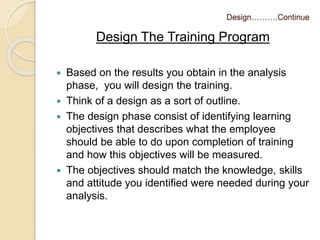On the job training methods
- 1. Methods to Implement for "On The Job Training" By Harshal Paranjape
- 2. Introduction In your job you may have spent time sitting through training sessions of questionable value. Now we are assigning you to develop a training program “On The Job” for the rest of your department.
- 3. Methods Analyze Design Develop Implement Evaluate This method is called as ADDIE Model
- 4. 1. Analyze
- 5. Analyze……….Continue Analyze The Training Need Who is your Audience? When you develop a program On The Job, you will take a look at what knowledge, skills an attitude the Employee need upon completing the program versus what knowledge, skills and attitude they have now. If there is a gap between desired performance and expected performance, what is the cause? Is training really the solution? When there is a gap, it might be because they can’t do the work because of physical limitations, lack of proper tool or equipments, environment etc.
- 6. Analyze……….Continue Or may be they know what to do but just don’t want to or won’t. In that case, you have a performance issue rather than a training issue. Training is only the solution when the audience member have not yet learned the information, skills or attitude needed to be successful on the job. Part of your analysis include assessing the resources and tools you will need versus what is available to you, the schedule for the training, and how the audience is likely to learn best.
- 7. 2. Design
- 8. Design……….Continue Design The Training Program Based on the results you obtain in the analysis phase, you will design the training. Think of a design as a sort of outline. The design phase consist of identifying learning objectives that describes what the employee should be able to do upon completion of training and how this objectives will be measured. The objectives should match the knowledge, skills and attitude you identified were needed during your analysis.
- 9. Design……….Continue You will also determine how the course will be delivered, such as by an instructor in a classroom, online or a blended approach. In the design phase, you may also create storyboards to aid in the development of the training program.
- 10. 3. Develop
- 11. Develop……….Continue Develop The Training Program In the development phase, use the objective and other materials you created during the design phase to flesh out your outline and develop the training program. The material may include online training components and manual for the instructor and employees. In this phase, you will develop a strategy for testing the employee’s change in knowledge, skills and attitude based on the training.
- 12. 4. Implement
- 13. Implement……….Continue Implement The Training Program The implementation phase is sometimes called the delivery phase. In this phase, you actually teach the training program to the employees, whether the instruction takes place online, in the classroom or through another method. If the delivery method is classroom instructions and you have a large audience, you may conduct a “train – the – trainer” program, where the facilitator sit through the class as employee and then practice teaching various parts of the material back to each other to ensure consistency and full understanding.
- 14. Implement……….Continue The first time the instructions is offered is called a “pilot” and there should be an opportunity to debrief and make changes based upon feedback from observers and the pilot audience.
- 15. 5. Evaluate
- 16. Evaluate……….Continue Evaluate The Training Program In the evaluation phase, you determine if the employee obtained the knowledge, skills or attitude you identified as the goals during the analysis phase. You can use the information you obtained during the evaluation phase to make additional changes to the design, development and delivery of the training program the next time you offer it to the employee. Depending on your needs, you will have to decide in an earlier phase what level of evaluation you will use.
- 17. Evaluate……….Continue Levels of Evaluation:- Level 1. Measures how the learners felt about the training i.e. did they like it?, did the believed they learned something? This evaluation can be accomplished with a simple questionnaire. Level 2. Measures whether the learners mastered the material delivered. This usually involves a test or having each learner successfully perform a task that was taught. Level 3. Requires following up with learners later, to determine if they are actually applying new skills on the job. Level 4. Where they determine whether there was an actual return on investment for putting the employees through the training program.
- 18. Evaluation Sheet : - Emp_Code Name of Appraisee Designation of Appraisee Date Of Joining Appraisal Period: Name of Appraiser Designation of Appraiser Jaika Motors Ltd. Employee Performance Appriasal form Attributes Sr. No Marks 1 Follows instructions to the satisfaction of superiors 3 2 Aims to develop good relations with internal and external customers 3 3 Able and willing to work effectively with others in a team 3 4 Communicates effectively to share information and/or skills with colleagues 3 5 Uses practices that save company resources and minimise wastage 3 6 Job knowledge 3 7 Commitments towards work 3 8 Plans and organized effectevely 3 9 Stay overtime whenever necessary 3 10 Willengness to learn 3
- 19. Evaluation Sheet………..Continue 11 3 12 3 13 3 14 3 15 3 16 3 17 3 18 3 19 3 20 3 60 Work accuracy Able to handle reasonable volumn of work Problem solving techniques Attendance Punctual Responsible Able to accept new things and technology Presentation skill Leadership Decision Making power Total 0 - 30 Unsatisfied 31 - 44 Need Improvement 45 - 59 Fair 60 - 75 Good 76 - 89 Very Good 90 - 100 Outstanding
- 20. Thank You



















